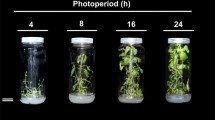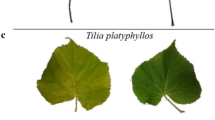Abstract
Chamomile (Matricaria chamomilla) in the above-ground organs synthesizes and accumulates (Z)- and (E)-2-β-d-glucopyranosyloxy-4-methoxy cinnamic acids (GMCA), the precursors of phytoanticipin herniarin (7-methoxycoumarin). The diurnal rhythmicity of the sum of GMCA (maximum before daybreak) and herniarin (acrophase at 10 h 21 min of circadian time) was observed under artificial lighting conditions LD 12:12. The acrophase is the time point of the maximum of the sinusoidal curve fitted to the experimental data. In continuous light, the circadian rhythms of both compounds were first described with similar acrophases of endogenous rhythms; a significantly different result from that in synchronized conditions. The rhythms’ mesor (the mean value of the sinusoidal curve fitted to the experimental data) under free-running conditions was not influenced. Abiotic stress under synchronized conditions decreased the average content of GMCA to half of the original level and eliminated the rhythmicity. In contrast, the rhythm of herniarin continued, though its content significantly increased. Nitrogen deficiency resulted in a significant increase in GMCA content, which did not manifest any rhythmicity while the rhythm of herniarin continued. Circadian control of herniarin could be considered as a component of the plant’s specialized defence mechanisms.





Similar content being viewed by others
Abbreviations
- GMCA:
-
(Z)- and (E)-2-β-d-glucopyranosyloxy-4-methoxy cinnamic acids
- LD:
-
Light–dark
- LL:
-
Continuous light
- MDA:
-
Malondialdehyde
References
Allen SE (1989) Chemical analysis of ecological materials. Oxford, Blackwell
Barros MP, Pinto E, Sigaud-Kutner TCS, Cardozo KHM, Colepicolo P (2005) Rhythmicity and oxidative/nitrosative stress in algae. Biol Rhythm Res 36:67–82
Bingham C, Arbogast B, Cornélissen G, Lee J-K, Halberg F (1982) Inferential statistical methods estimating and comparing cosinor parameters. Chronobiologia 9:397–439
Borevitz JO, Xia Y, Blount J, Dixon RA, Lamb C (2000) Activation tagging identifies a conserved MYB regulation of phenylpropanoid biosynthesis. Plant Cell 12:2383–2393
Bourgaud F, Hehn A, Larbat R, Doerper S, Gontier E, Kellner S, Matern U (2006) Biosynthesis of coumarins in plants: a major pathway still to be unravelled for cytochrome P450 enzymes. Phytochem Rev 5:293–308
Brunke E-J, Hammerschmidt F-J, Schmaus G (1993) Flower scent of some traditional medicinal plants. In: Teranishi R, Buttery RG, Sugisawa H (eds) Bioactive volatile compound from plants. American Chemical Society, Washington, pp 282–296
Ceska O, Chaudhary SK, Warrington PJ, Ashwood-Smith MJ (1992) Coumarins of chamomile, Chamomilla recutita. Fitoterapia 63:387–394
Cornelissen G, Halberg F, Stebings J, Halberg E, Caradente F, Hsi B (1980) Chronobiometry with pocket calculators and computer systems. Ric Clin Lab 10:333–385
Covington MF, Maloof JN, Straume M, Kay SA, Harmer SL (2008) Global transcriptome analysis reveals circadian regulation of key pathways in plant growth and development. Genome Biol 9:R130
Dixon RA, Paiva NL (1995) Stress-induced phenylpropanoid metabolism. Plant Cell 7:1085–1097
Dowson-Day MJ, Millar AJ (1999) Circadian dysfunction causes aberrant hypocotyl elongation patterns in Arabidopsis. Plant J 17:63–71
Eliašová A, Repčák M, Pastírová A (2004) Quantitative changes of secondary metabolites of Matricaria chamomilla by abiotic stress. Z Naturforsch 59c:543–548
Halberg F, Tong YL, Johnson EA (1967) Circadian system phase—an aspect of temporal morphology: procedures and illustrative examples. In: von Mayersbach H (ed) The cellular aspects of biorhythms. Springer, Berlin, pp 20–48
Hardeland R, Coto-Montes A, Poeggeler B (2003) Circadian rhythms, oxidative stress, and antioxidative defense mechanisms. Chronobiol Int 20:921–962
Harmer SL, Hogenesch JB, Straume M, Chang HS, Han B, Zhu T, Wang X, Kreps JA, Kay SA (2000) Orchestrated transcription of key pathways in Arabidopsis by circadian clock. Science 290:2110–2113
Hofer O, Szabó G, Greger H (1986) 2-hydroxy-4-methoxy-trans-cinnamic acid as a precursor of herniarin in Artemisia dracunculus. Mh Chem 117:1219–1222
Kolař J, Macháčková I (2005) Melatonin in higher plants: occurrence and possible functions. J Pineal Res 39:333–341
Kováčik J, Bačkor M (2007) Changes of phenolic metabolism and oxidative status in nitrogen-deficient Matricaria chamomilla plants. Plant Soil 297:255–265
Kováčik J, Klejdus B (2008) Dynamics of phenolic acids and lignin accumulation in metal-treated Matricaria chamomilla roots. Plant Cell Rep 27:605–615
Kováčik J, Tomko J, Bačkor M, Repčák M (2006) Matricaria chamomilla is not a hyperaccumulator, but tolerant to cadmium stress. Plant Growth Regul 50:239–247
Kováčik J, Klejdus B, Bačkor M, Repčák M (2007) Phenylalanine ammonia-lyase activity and phenolic compounds accumulation in nitrogen deficient Matricaria chamomilla leaf rosettes. Plant Sci 172:393–399
Kováčik J, Grúz J, Bačkor M, Tomko J, Strnad M, Repčák M (2008) Phenolic compounds composition and physiological attributes of Matricaria chamomilla grown in copper excess. Environ Exp Bot 62:145–152
Lin HC, Tsai SH, Chen CS, Chang YC, Lee CM, Lai ZY, Lin CM (2008) Structure–activity relationship of coumarin derivatives on xanthine oxidase-inhibiting and free radical scavenging activities. Biochem Pharmacol 75:1416–1425
Loughrin JH, Hamilton-Kemp TR, Andersen RA, Hildebrand DF (1991) Circadian rhythm of volatile emission from flowers of Nicotiana sylvestris and N. suaveolens. Physiol Plant 83:492–496
Mares D (2005) Fungal morphogenesis induced by natural and synthetic substances: herniarin-induced alterations in the dermatophyte Microsporum cookei Ajello. Plant Biosyst 139:323–334
Martin DM, Gershenzon J, Bohlmann J (2003) Induction of volatile terpene biosynthesis and diurnal emission by methyl jasmonate in foliage of Norway spruce. Plant Physiol 132:1586–1599
McClung CR (2008) Comes a time. Curr Opin Plant Biol 11:514–520
Morant AV, Jorgensen K, Jorgensen C, Paquette SM, Sánchez-Pérez R, Møller L, Bak S (2008) β-Glucosidases as detonators of plant chemical defense. Phytochemistry 69:1795–1813
Nováková M, Motyka V, Dobrev PI, Malbeck J, Gaudinová A, Vanková R (2005) Diurnal variation of cytokinin, auxin and abscisic acid levels in tobacco leaves. J Exp Bot 56:2877–2883
Nozue K, Covington MF, Duek PD, Lorrain S, Fankhauser C, Harmer SL, Maloof JN (2007) Rhythmic growth explained by coincidence between internal and external cues. Nature 448(7151):358–361
Repčák M, Imrich J, Franeková M (2001) Umbelliferone, a stress metabolite of Chamomilla recutita (L.) Rauschert. J Plant Physiol 158:1085–1087
Rogers LA, Dubos C, Cullis IF, Surman C, Poole M, Wilment J, Mansfield SD, Campbell MM (2005) Light, the circadian clock, and sugar perception in the control of lignin biosynthesis. J Exp Bot 56:1651–1663
Surburg H, Guentert M, Harder H (1993) Volatile compounds from flowers. Analytical and olfactory aspects. In: Teranishi R, Buttery RG, Sugisawa H (eds) Bioactive volatile compound from plants. American Chemical Society, Washington, pp 168–186
Tosi B, Romagnoli C, Menziani-Andreoli E, Bruni A (1995) Characterization of coumarins in chamomile preparations sold in Italy. Int J Pharmacogn 33:144–147
VanEtten HD, Mansfield JW, Bailey JA, Farmer EE (1994) Two classes of plant antibiotics: phytoalexins versus “phytoanticipins”. Plant Cell 6:1191–1192
Yakir E, Hilman D, Harir Y, Green RM (2007) Regulation of output from the plant circadian clock. FEBS J 274:335–345
Acknowledgment
This work was supported by the grant agency VEGA (project no. 1/0444/03). We thank Mrs. Anna Michalčová and Mrs. Margita Buzinkaiová for their valuable technical assistance.
Author information
Authors and Affiliations
Corresponding author
Additional information
Communicated by M. Petersen.
Rights and permissions
About this article
Cite this article
Repčák, M., Šmajda, B., Kováčik, J. et al. Circadian rhythm of (Z)- and (E)-2-β-d-glucopyranosyloxy-4-methoxy cinnamic acids and herniarin in leaves of Matricaria chamomilla . Plant Cell Rep 28, 1137–1143 (2009). https://doi.org/10.1007/s00299-009-0708-0
Received:
Revised:
Accepted:
Published:
Issue Date:
DOI: https://doi.org/10.1007/s00299-009-0708-0




